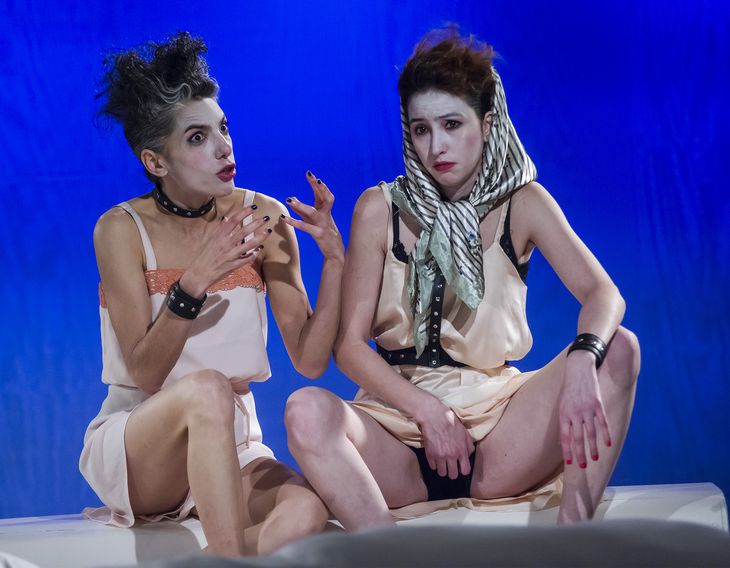“Mental health is an issue that slides between the sheets as an inevitable ghost. The bed, which many see as a shelter, can also be a prison ”, says Zoe di rienzo, who stars “What magnificent is me?” next to Sofia Gala Castiglione and Analía Couceyro.
Sofia Gala: I was attracted to the qualification of people I want and the text written by a great friend like Liliana seemed very interesting because she is sharp, she has humor, she speaks of women, feminism, history, heroines of history that we might not know and were there.
Zoe di Renzo: His brutal honesty disguised as irony and asking questions that we all avoid. Liliana Viola did not write a character, wrote a reflection. Zoe di Rienzo is not just a name, it is an act of balance: between the mundane and the sublime, between being an real estate artist and broker, between loading with other people’s expectations and rebelling against them. Every detail, the black humor, the letters of the Rencini, my great -great grandmother, the references in art, the conversations with Alexa, resonates with me. Participating in this work is more than acting; It is to inhabit it, question and rebuild me. Because, in the end, what magnificent has to be? Everything, both inhabit chaos, as well as that structure that supports us in the day to day. And this work reminds me.
Analía Couceyro: I said that if to work before the text trusting Lili Viola and the team. I knew what the idea of the text was, I accepted, and it was what I expected and more.
Q.: The bed is often associated with depression, how does Mental Health play in the work?
SG: The work speaks a lot of mental health and sometimes associated with depression however John and Yoko did the Bed in in the 70s with a treaty on peace. Make love and not war. The bed is for sex and moments of leisure, and also associated with mental health but the work covers everything. Both Zoe, the actress and her great -grandmother, were diagnosed with diseases as well as everyone is now diagnosed with something, that is also talked about. Everyone has something. I see the young people of 20 and everyone has attention deficit disorders, I feel that we all have them, only a few years ago it was not called or not diagnosed. Medical diagnoses of today and 1500, a parable between this era and today.
SDR: In this work, the bed is witnessing and complicit in a mind that does not give up, but dares to question everything. In the background, the message is clear: there is no possible mental health in everyday life, if we are not able to stop, to listen to our own silences and our most uncomfortable words.
AC: Mental health is present in the work with humor and the bed is linked to depression but also the work plays with overdiagnostication, a period evil, and also with the fear of depression that hides the fear of non -productivity.
DSC_2065.Thic of magnificent
Q: How is this theory of life in a horizontal position?
SG: The idea begins with Zoe’s ancestor and Zoe follows it, at that time it had to do with stoping and lying down, which meant stopping the obligations, mandates, general and female. From her diseases, she decides to stay in bed and start her horizontal theory. Talking from the bed about what the bed means, sleeping, being lying.
SDR: It is simple: the bed is not inaction, it is resistance. It is where everything happens: it is born, loves, dreams and dies. It is a space to think, rebel and exist without the demands of the world standing that constantly demands us more. Gravity throws us, but the bed holds us, and there, perhaps, there is true freedom.
AC: It has to do with claiming leisure and understanding what is put into play in relation to the bed. It is a very important home space, where the body rests and at the same time is linked to birth, death, love and work claims that link with the body and that leisure space.
Q.: How was the revolution to leave the bed of Zoe’s great -grandmother in full bubonic plague?
AC: According to the work at that time, not getting out of bed was the revolution. It is a kind of protofeminist who makes the decision not to comply with the mandates expected of a woman and there she decides not to get out of bed and receive lovers and friends in her bed. It is released from corsets and invents nightgown.
Q.: How is a work around a bed?
SG: It is pleasant but it was difficult because at no time with Analía we left that bed, it is our scenario, then at some point that limit was a challenge, finding our bodies in a bed, neither stand up or sit down.
AC: It is in a broad sense because it is thought during the work in bed and its associations and at the same time the bed is the scenographic object par excellence of the work. It has something fun and challenging to act in that space that is a kind of ring or scenario from which we do not leave.
Q.: How do you see theater and culture today?
SG: As a resistance place where it is important to sustain and have interesting and important things to say. In moments of crisis as important as now, with a state that plays against war, very interesting things can come out. I see great battle against but also an opportunity for artists to wake up and start talking about important and transcendent things, in recent times culture became a bit banal. As much as they put the rope around our neck it is important to wake up, for artists and for those who come to see us.
AC: The theater, once again, is a focus of resistance and vitality. There is something of the theater that survives through the centuries and always has that vitality of its present. Today, in spite of everything and the de -financing, it remains the space of resistance and reflection in moments of hate speeches and little sensitivity.
Source: Ambito
I am an author and journalist who has worked in the entertainment industry for over a decade. I currently work as a news editor at a major news website, and my focus is on covering the latest trends in entertainment. I also write occasional pieces for other outlets, and have authored two books about the entertainment industry.




